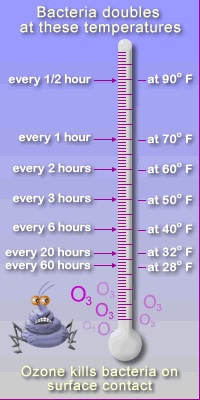
CAN OZONE KILL PATHOGENS
| Pathogen | Dosage |
| Aspergillus Niger (Black Mount) | Destroyed by 1.5 to 2 mg/I |
| Bacillus Bacteria | Destroyed by 0.2 m/I within 30 seconds |
| Bacillus Anthracis (causes anthrax in sheep, cattle and pigs.� Also a human pathogen) | Ozone susceptible |
| Bacillus cereus | 99% destruction after 5-min at 0.12 mg/l in water |
| B. cereus (spores) | 99% destruction after 5-min at 2.3 mg/l in water |
| Bacillus subtilis | 90% reduction at 0.10-PPM for 33 minutes |
| Bacteriophage f2 | 99.99% destruction at 0.41 mg/l for 10-seconds in water |
| Botrytis cinerea | 3.8 mg/l for 2 minutes |
| Candida Bacteria | Ozone susceptible |
| Clavibacter michiganense | 99.99% destruction at 1.1 mg/l for 5 minutes |
| Cladosporium | 90% reduction at 0.10-PPM for 12.1 minutes |
| Clostridium Bacteria | Ozone susceptible |
| Clostridium Botulinum Spores. Its toxin paralyses the central nerve system, being a poison multiplying in food and meals. | 0.4 to 0.5 mg/l threshold value |
| Coxsackie Virus A9 | 95% destruction at 0.035 mg/l for 10-seconds in water |
| Coxsackie Virus B5 | 99.99% destruction at 0.4 mg/l for 2.5-minutes in sludge effluent |
| Diphtheria Pathogen | Destroyed by 1.5 to 2 mg/l |
| Eberth Bacillus (Typhus abdomanalis).� Spreads typically by aqueous infection and causes typhoid. | Destroyed by 1.5 to 2 mg/l |
| Echo Virus 29: The virus most sensitive to ozone. | After a contact time of 1 minute at 1 mg/l of ozone, 99.999% killed. |
| Enteric virus | 95% destruction at 4.1 mg/l for 29 minutes in raw wastewater |
| Escherichia Coli Bacteria (from feces) | Destroyed by 0.2 mg/l within 30 seconds in air |
| E-coli (in clean water) | 99.99% destruction at 0.25 mg/l for 1.6 minutes |
| E-coli (in wastewater) | 99.9% destruction at 2.2 mg/l for 19 minutes |
| Encephalomyocarditis Virus | Destroyed to zero level in less than 30 seconds with 0.1 to 0.8 mg/l. |
| Endamoebic Cysts Bacteria | Ozone susceptible |
| Enterovirus Virus | Destroyed to zero level in less than 30 seconds with 0.1 to 0.8 mg/l. |
| Fusarium oxysporum f.sp. lycopersici | 1.1 mg/l for 10 minutes |
| Fusarium oxysporum f.sp. melonogea | 99.99 % destruction at 1.1 mg/l for 20 minutes |
| GDVII Virus | Destroyed to zero level in less than 30 seconds with 0.1 to 0.8 mg/l. |
| Hepatitis A virus | 99.5% reduction at 0.25 mg/l for 2-seconds in a phosphate buffer |
| Herpes Virus | Destroyed to zero level in less than 30 seconds wit 0.1 to 0.8 mg/l. |
| Influenza Virus | 0.4 to 0.5 mg/l threshold value |
| Klebs-Loffler Bacillus | Destroyed by 1.5 to 2 mg/l |
| Legionella pneumophila | 99.99% destruction at 0.32 mg/l for 20 minutes in distilled water |
| Luminescent Basidiomycetes (species having no melanin pigment). | Destroyed in 10 minutes at 100-PPM |
| Mucor piriformis | 3.8 mg/l for 2 minutes |
| Mycobacterium avium | 99.9%
with a CT value of 0.17 in water (scientifically reviewed document) |
| Mycobacterium foruitum | 90% destruction at 0.25 mg/l for 1.6 minutes in water |
| Penicillium Bacteria | Ozone susceptible |
| Phytophthora parasitica | 3.8 mg/l for 2 minutes |
| Poliomyelitis Virus | 99.99% kill with 0.3 to 0.4 mg/l in 3-4 minutes |
| Poliovirus type 1 | 99.5% destruction at 0.25 mg/l for 1.6 minutes in water |
| Proteus Bacteria | Very susceptible |
| Pseudomonas Bacteria | Very susceptible |
| Rhabdovirus virus | Destroyed to zero level in less than 30 seconds with 0.1 to 0.8 mg/l |
| Salmonella Bacteria | Very susceptible |
| Salmonella typhimurium | 99.99% destruction at 0.25 mg/l for 1.67 minutes in water |
| Schistosoma Bacteria | Very susceptible |
| Staph epidermidis | 90% reduction at 0.1-ppm for 1.7 min |
| Staphylococci | Destroyed by 1.5 to 2.0 mg/l |
| Stomatitis Virus | Destroyed to zero level in less than 30 seconds with 0.1 to 0.8 mg/l |
| Streptococcus Bacteria | Destroyed by 0.2 mg/l within 30 seconds |
| Verticillium dahliae | 99.99 % destruction at 1.1 mg/l for 20 minutes |
| Vesicular Virus | Destroyed to zero level in less than 30 seconds with 0.1 to 0.8 mg/l |
| Virbrio Cholera Bacteria | Very susceptible |
| Vicia Faba progeny | Ozone causes chromosome aberration and its effect is twice that observed by the action of X-rays |
source
http://www.ozoneapplications.com/info/ozone_bacteria_mold_viruses.htm